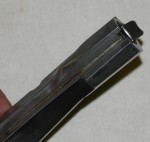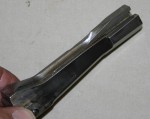The first prototypes of the FAL rifle were produced by Fabrique Nationale on the company’s own initiative in the aftermath of World War II, and presented to the British government for testing in early 1947. Initial tests were made at the Enfield ranges in April of 1948, comparing the FN Carbine in 7.92×33 Kurz (later to evolve into the FAL) against a Sten gun, an M2 .30-cal Carbine, and a German MP44. The FN Carbine performed will in the testing (we will cover this rifle more extensively in a separate article later on), but the British government was looking for a cartridge larger than the German Kurz round. The result was the first FAL (Fusil Automatique Leger, or light automatic rifle).

This first FAL was chambered for the .280/30 cartridge, which was a compromise cartridge using the .280 (7mm) bore diameter believed ideal by the British at the time and the general case dimensions of the American T65 cartridge (which would become the 7.62×51 NATO). It fired a 140 grain bullet at 2400 fps, with the intention of being an intermediate cartridge that could be used accurately with full-auto shoulder fire. The rifle itself was remarkably similar to the final production versions of the FAL, differing only in details. The locking and operating mechanisms were well enough developed in the early design that they did not need to be changed throughout later development.
Testing of this rifle took place in 1950 at Aberdeen Proving Grounds in Maryland,alongside the EM2 (also in .280/30 caliber) and the American T25, a development of the M1 Garand chambered for the T65 .30-caliber cartridge. The FAL performed well in testing, and was much admired by the British troops present. It also gained respect among the Americans for reliability. In fairness to the T25 rifle, the T65 ammunition used at the trials was an experimental batch and had consistency problems which led to malfunctions in the T25.
There were three written American objections to the .280 FAL, and one unwritten. The written complaints were its low velocity, poor arctic performance, and small bullet volume. The low velocity was deliberate to improve automatic fire accuracy, but the Americans were concerned that when firing at 700 yards the bullet would be 8 feet high at 400 yards, thus entirely missing a target at that distance. The British counterpoint to this was to note that the declared maximum range of the round was 600 yards. Considering the USSR as the most anticipated enemy at the time, arctic combat was a more significant concern than today, and low temperatures would only exacerbate the trajectory issues claimed by the American observers. Finally, the US military had a stated need for tracer and observation (explosive) cartridges for its infantry rifle, and it was claimed that the 7mm bore was too small to contain enough material to make effective projectiles of these types (later experience would prove this claim wrong). The major unwritten objection to the FAL was that it was not an American development. The head of the US Ordnance R&D, Colonel Rene Studler, was fundamentally unwilling to adopt a foreign rifle design.
Unfortunately, a major opportunity to reach a compromise was lost when the American and British delegations came to different understandings of the testing results. The British came away with the understanding that the .280 cartridge needed further development, while the American take-away was that the .280 was fundamentally unsound.
Photos
One of the .280/30 prototype FAL rifles built for 1950 trials, courtesy of the UK MoD (click here to download the gallery in high resolution)
































i really like the handguard on this FAL prototype gun.i want my gun to look exacly like this one,can anybody help?
I’d like to have a FAL that IS exactly like this one, caliber included. Sure, I’d have to make my own ammo, but if I were able to afford having a custom-made .280 FAL, that would be a non-issue.
Why would you need to make your own ammunition?
Ever hear of 7mm-08? aka 7x51mm. Available at any Walmart.
The .280 was developed prior to the final design of the 7.62mm NATO, and the brass is not interchangeable.
Why is it claimed the first FAL was 280/30 and not the 7.92x33Kurz?
This is the first and only source that claims this.
A answer would be nice to clarify any mistaken information or understanding I have
Great website though
Yes, the 8×33 FAL was done first, but it was a one-off prototype while the .280/30 went into limited production.
I thought the 280s were also just prototypes too.
Yes more were made but still prototypes.
Where does prototype end and a production model begin?
Aren’t prototypes for evaluation and testing.
Production both limited and normal are for contracts/sales.
Thanks
From what I’ve read, the Belgians and I think the Brits actually started production on the .280/30 FALs until the US jammed the 7.62 down everyone’s throat. At which point production of the FAL as we know it today began.
FN started limited production of the FAL in .280/30, before switching to 7.62×51 thanks to the US forcing NATO to adopt it. Allegedly the US agreed to adopt the FAL (like most of the rest of NATO) in exchange for everybody adopting the 7.62 round, but they reneged on that despite the T48 (FAL) outperforming the T44 (M14) in most respects during testing. To justify that decision, they blatantly rigging the cold weather phase of the testing in the M14’s favor and falsely claimed they’d be able to use existing M1 Garand production machinery to make the M14.
Meanwhile, Britain adopted the EM-2 (also chambered for .280/30) as the No.9 Mk1 before NATO standardization forced them to reverse that decision. Unlike the FAL, the EM-2 was unsuitable for the more powerful 7.62×51 round, so Britain used their own version of the FAL (the L1A1 SLR) instead. British FALs were always chambered for 7.62×51.
The only FALs that ever went into actually service in a chambering other than 7.62×51 were the first batch of Venezuelan FALs in 7mm Liviano (7×49), which was a slightly more powerful variant of the .280/30 cartridge and ballistically similar to the later 7mm-08. Despite being unaffiliated with NATO, though, the Venezuelans felt the need to take a step backward by switching to 7.62×51, presumably to take advantage of American military aid in the form of free ammo.
At that time, the American brass were idiots who failed to comprehend the very concept of an assault rifle. And their stupidity set back all of NATO for decades.
I’d argue that American weapons development was held back by interference from unqualified, but influential US Army officers combined with a dogmatic adherence to traditional rifle aesthetics. Sometimes it much better to let the boffins make the technical decisions, and the British were right onto that with regards to the 280 round. Example: The BAR, the Poles clearly understood the concept with QC barrels and pistol grips for better control, but the Americans treated it as a glorified hunting rifle. The M14, its just a re-jigged M1 and a poor battle rifle (even if you disregard the issues with automatic fire) The FAL was clearly the better option, and the AR-10 if given time to develop, less so, but better than the M14.
Matter of fact, the perfect rifle would’ve being the AR-10 in 280 Brit. Retrospectively, that would’ve solved replacing the M14, the constant re-jigging of the AR platform in 5.56 and the on-going issues with underperformance of the 5.56 at range. Naturally, both the AR-10 and 280 round would’ve evolved from its embryonic phase in the 50’s as new propellants and machining techniques get utilised, in much the same way as the M16 has evolved and the 5.56 has too. Considering that nothing will change while the US still cling to the AR platform, adopting the AR-10 in 280 back in the day could’ve solved 90% of todays problems. But then again, the search for an intermediate round is a white whale, when single platform/multi calibre rifles look like the answer.
Ironically, in the 1920s US Ordnance developed a .276 round (Pedersen) that tested extremely well, and was killed off for political reasons. The British after WW2 developed the .280 round that was similar. Now, the US Military has finally adopted the .277 round (For now on a limited basis). So, it took 100 years for us to get there, but we finally adopted an intermediate caliber Military cartridge.
Most cameras with a zoom lens will lose light when they are zooemd in due to the long focal lenght. The first shot was taken under a covered shelter with tha camera focused on the rear optic of the scope muted light. The second shot was taken under the same shelter (assumed) but zooemd in on a very light colored target on a light background this will cause the camera’s light meter to adjust down changing the look of the shot as you pointed out. The sighting in system works well.
So the .280/30 is basically a remington 7mm-08?
Not even close